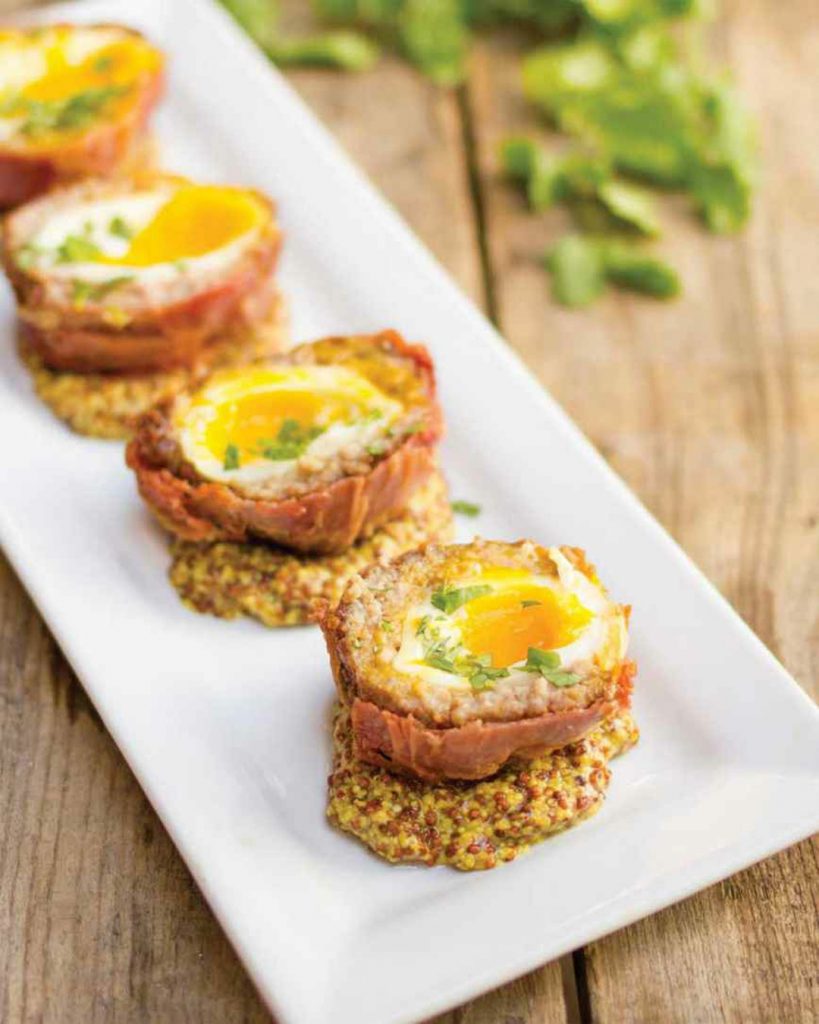 The keys to making perfect Scotch eggs are to cook perfect soft-boiled eggs not overcooked or rubbery ones and to get the frying oil to the right temperature. Oil that’s not hot enough creates soggy and oily fried foods, but if it’s too hot, the exterior will burn before the interior in this case the ground pork has a chance to cook. The first time I made Scotch eggs, the oil was too hot. When I dropped my first egg in the pot, the oil boiled over and started a fire, and the prosciutto wrapper cooked so fast that the pork inside was still raw. Learn from my mistake and use a thermometer to check the oil temperature! The classic method for cooking Scotch eggs is to fry them, but I’ve also included an oven-cooked variation if you prefer to prepare them that way.
The keys to making perfect Scotch eggs are to cook perfect soft-boiled eggs not overcooked or rubbery ones and to get the frying oil to the right temperature. Oil that’s not hot enough creates soggy and oily fried foods, but if it’s too hot, the exterior will burn before the interior in this case the ground pork has a chance to cook. The first time I made Scotch eggs, the oil was too hot. When I dropped my first egg in the pot, the oil boiled over and started a fire, and the prosciutto wrapper cooked so fast that the pork inside was still raw. Learn from my mistake and use a thermometer to check the oil temperature! The classic method for cooking Scotch eggs is to fry them, but I’ve also included an oven-cooked variation if you prefer to prepare them that way.
Ingredients
- To cook perfect soft-boiled eggs, fill a medium saucepan halfway with water and bring to a simmer, not quite a boil. Gently place the eggs in the simmering water and cook for 5 minutes, holding the water at a simmer, not a boil. Remove the eggs from the water and run under cool water. Once cool, carefully peel the eggs and set them aside.
- Preheat the oil to 350°F in a deep-fryer or a 4-inch-deep (or deeper) cast-iron skillet over medium heat. The oil should be at least 3 inches deep; add more oil if needed. While the oil heats, assemble the eggs.
- In a medium bowl, mix the ground pork with the salt until well combined. Place one-third of the pork on a piece of parchment paper, and, using your hands, flatten it out into as thin a circle as possible. Place a soft-boiled egg in the center of the meat and wrap the meat up and around the egg. Secure it closed by pressing the meat together, being careful not to break open the egg.
- Lay out 2 pieces of prosciutto like an X on a sushi mat or a sheet of parchment paper. Place the pork-covered egg in the middle. Fold the prosciutto “arms” around the egg.
- When the oil has reached 350°F (check it with a thermometer), fry the eggs: Gently drop one egg at a time into the hot oil. Fry for 5 to 6 minutes, until the prosciutto is crispy and the pork is cooked through. Remove from the oil and set aside on a paper towel to drain. Repeat with the remaining two eggs, frying them one at a time.
- To serve, place six 1-tablespoon amounts of whole-grain mustard on a serving platter. Slice each fried egg in half with a very sharp serrated knife. Place the halves, cut side up, on top of the mustard (which keeps the eggs from sliding around on the platter). Garnish with the cilantro.
- Reheat leftovers on a rimmed baking sheet in a 400°F oven for 7 minutes, or until heated through.
| Nutrition Facts |
Serving Size 1 |
Nutritional Value Per Serving |
| Calories 430 kcal Calories from Fat: 297 kcal |
|
% Daily Value*
|
| Total Fat 33 g 94% |
Trans Fat 0.0 g |
carbohydrates 1 g 1% |
Dietary Fiber 0.2 g 1% |
Protein 33 g 66% |
* Above mentioned %DVs (Percent Daily Values) are based on 2,000 calorie food intake.
DVs (Daily values) may be vary depending upon individuals daily calorie needs. Above nutritional values are estimates and should only be used as a guide for approximation. They are not allfoodchef.com recommendations. Calculations are based on average weight of 194 lbs. and ages of 19 to 50 years. |
